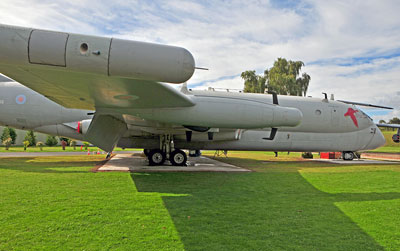Nimrod R1 unveiling at Cosford RAF Museum
Saturday, September 29th, 2012
I was fortunate enough to be invited to represent Airscene, at RAF Cosford, to see the Nimrod R1 XV249 officially handed over to the museum by Air Chief Marshall Sir Brian Burridge. I say fortunate; because the other invited guests, at the “by invitation only” ceremony, also included Air Marshall Sir Kevin Leeson and personnel, past and present, from 51 Squadron – the only squadron to have flown the Nimrod R1 during its 40 years service with the RAF.
I arrived at Cosford early, in an effort to shoot some images of XV249 before the area became too crowded and I managed to get some “people free” images of the Nimrod. The R1 is parked immediately beyond the main entrance doors to the static area and the aircraft provides a new and impressive welcome for visitors to the museum.
Getting the R1 to RAF Cosford has been a long and difficult journey. And, XV249 is not just any old Nimrod – having flown in both the Maritime Patrol and Electronic Intelligence Roles and clocked up over 18,000 hours during her service. She is one of only 4 R1 models from a total production of 46 aircraft delivered to the RAF.
Delivery of the fuselage was taken in early March 2012, after it was transported from Kemble. The wings and other parts duly followed and she was re-assembled at Cosford during the summer.
Having just about exhausted most of the camera angles I could, I joined with the other guests for refreshments and had the chance to chat to members of 51 Squadron – both past and present. They hold the Nimrod in fond esteem and like us all, they had showed concern when following a Strategic Review, the Nimrod program had been cancelled.
How ironic then, that the Sentinel R1, which is the RAF’s current electronic intelligence gathering aircraft, failed to perform the planned flypast to mark the Nimrod Ceremony. No official mention was made of the “no show” or, indeed, the aircraft’s display slot in the program, but, it could be that the Sentinel R1 had developed a technical fault which could not be rectified in time for the ceremony.
Built as a Nimrod MR. Mk 1, XV249 made its first flight in 1970 with delivery to the RAF in early 1971. In 1976 she was involved in the ‘Cod War’ and also participated in Operation Tapestry which involved Fishery Protection and Gas Platform Surveillance. In March 1985, XV249 was delivered to RAF Kinloss having been converted to MR Mk 2 standard, being fitted with a new avionics and equipment suite and having the Shackleton-era radar replaced with the EMI Searchwater System.
In October 1995, XV249 went to BAe Woodford and was stripped of all ASW equipment and converted to R1 standard with the installation of additional atenna fittings. From 1997 she was flown as a fully equipped R Mk1 aircraft and in May 2011, after operations in Libya, she was withdrawn from normal service. In 2012, dismantling began at Kemble.
Guests and Museum staff gathered around the aircraft and were addressed by Peter Dye, the RAF Museum Director General, who expressed his thanks to all those involved in getting the aircraft to Cosford and undertaking the complicated task of re-assembling this unique Nimrod.
Air Chief Marshal Sir Brian Burridge, an ex Nimrod Pilot himself, gave an interesting address about the aircraft and recounted some of his own Nimrod stories. His speech offered a great insight into operational flying of the type and was both informative and entertaining. Finally, Air Marshal Sir Kevin Leeson formally handed over the aircraft’s log book and, in return, was presented with a ‘mounted’ bolt taken from the Nimrod’s wing structure. I can only hope that the bolt does not play an important part in maintaining airframe integrity!
So now I know much more about what I thought was just a converted DH Comet – and I was impressed, both with the aircraft and the crews that flew her – the plane may be consigned to history now, but if you want to discover more, like I did, take a trip to Cosford and marvel at another fine example of British aviation design and technical innovation – the Nimrod R1.




(Report and photos by Dave Briers)
